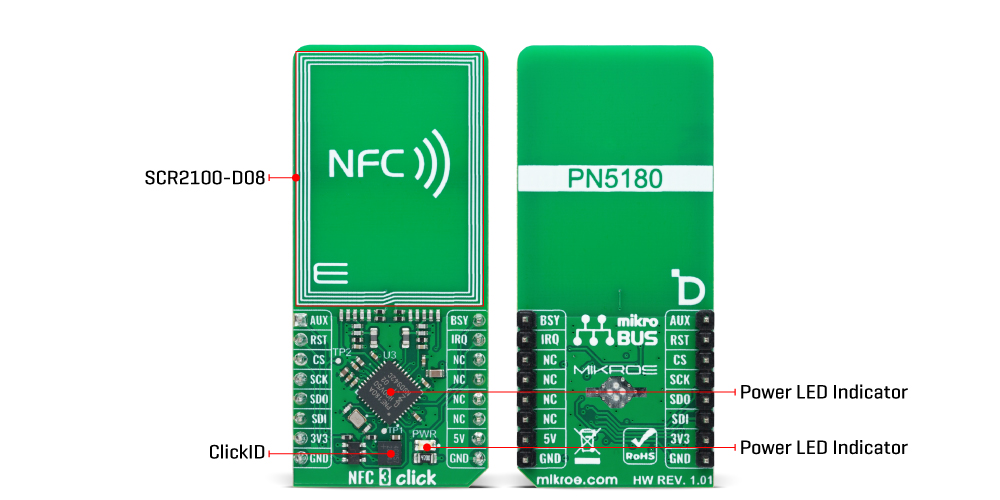OFF
GO LOCAL
| Company | Stock | Price |
|---|---|---|

MIKROE-5538
18 g
Status:
NFC 3 Click is a compact add-on board that contains an NFC transceiver for contactless communication at 13.56MHz. This board features the PN5180A0HN, a highly integrated high-performance full NFC Forum-compliant frontend from NXP Semiconductors. The PN5180A0HN utilizes an outstanding modulation and demodulation concept for different contactless communication methods and protocols. It is fully compliant with many Reader/Writer standards (ISO 14443A/B, ISO 15693, ISO 18092, and more), alongside support for reading all NFC tag types (type 1, 2, 3, 4A, and 4B). Besides the SPI host interface, it also features high RF output power to drive an antenna etched on the PCB directly, besides its tuning circuit, at high efficiency. This Click board™ represents an ideal solution for rapidly integrating NFC technology into any custom application.
NFC 3 Click is fully compatible with the mikroBUS™ socket and can be used on any host system supporting the mikroBUS™ standard. It comes with the mikroSDK open-source libraries, offering unparalleled flexibility for evaluation and customization. What sets this Click board™ apart is the groundbreaking ClickID feature, enabling your host system to seamlessly and automatically detect and identify this add-on board.
This product is no longer in stock
Availability date:
OFF
| Company | Stock | Price |
|---|---|---|

NFC 3 Click is based on the PN5180A0HN, a high-performance multiprotocol full NFC frontend from NXP Semiconductors, for contactless communication at 13.56MHz. The PN5180A0HN implements the RF and all the low-level functionality, like an antenna driving and receiver circuitry, to realize an NFC Forum-compliant reader. It utilizes an outstanding modulation and demodulation concept for different contactless communication methods and protocols. The PN5180A0HN is fully compliant with many Reader/Writer standards like ISO 14443A/B up to 848 kBit/s, JIS X 6319-4 comparable with FeliCa scheme, ISO 15693, ISO 18092, and more. Alongside support for reading all NFC tag types (type 1, 2, 3, 4A, and 4B) and high RF output power, this Click board™ is ideally suited for industrial and consumer NFC applications like industrial, eGov readers, payment terminals, and more.

This Click board™ connects to a host MCU with an SPI interface for configuration, NFC data exchange, and high-level NFC protocol implementation. It supports the most common SPI Mode 0 and operates with data rates up to 7 Mbit/s. The PN5180A0HN has two types of integrated memories: RAM and EEPROM. Internal registers of the PN5180A0HN store configuration data, while the RF configuration for dedicated RF protocols is defined by EEPROM data, copied by a command issued from the host MCU. This allows users to achieve maximum RF performance from a given antenna design.
In addition to the SPI interface signals, this board uses several other signals from the mikroBUS™ socket. The reset pin routed on the RST pin of the mikroBUS™ socket provides the general reset ability, while the IRQ pin of the mikroBUS™ socket represents an interrupt request to inform the host controller of various events.
The PN5180A0HN also has the possibility of updating the implemented firmware. In Secure Firmware update mode, the PN5180A0HN requires dedicated physical handling of the SPI interface lines and the BSY line of the mikroBUS™ socket. The BSY signal is used to indicate that the PN5180A0HN is not able to send or receive data over the SPI interface. The secure firmware download mode is entered by setting the AUX pin to a high logic state during the Start-Up sequence of the device. The AUX pin is allowed for any other functionality after Start-Up (as test signals provided by test points on the board); the level of this pin has no impact on the download functionality after Start-Up during standard NFC operation.
This Click board™ can only be operated from a 3.3V logic voltage level. Therefore, the board must perform appropriate logic voltage level conversion before using MCUs with different logic levels. However, the Click board™ comes equipped with a library containing functions and an example code that can be used as a reference for further development.
Type
RFID/NFC
Applications
Can be used for industrial and consumer NFC applications like industrial, eGov readers, payment terminals, and more
On-board modules
PN5180A0HN - multiprotocol NFC frontend from NXP Semiconductors
Key Features
High performance, full NFC Forum-compliant frontend, contactless communication at 13.56MHz, fully compliant with many Reader/Writer standards, reading of all NFC tag types, SPI interface, high RF power, possibility of updating the implemented firmware, and more
Interface
SPI
Feature
ClickID
Compatibility
mikroBUS™
Click board size
L (57.15 x 25.4 mm)
Input Voltage
3.3V,5V
This table shows how the pinout on NFC 3 Click corresponds to the pinout on the mikroBUS™ socket (the latter shown in the two middle columns).
| Label | Name | Default | Description |
|---|---|---|---|
| LD1 | PWR | - | Power LED Indicator |
| Description | Min | Typ | Max | Unit |
|---|---|---|---|---|
| Supply Voltage | - | 3.3 | - | V |
| Operating Frequency | - | 13.56 | - | MHz |
We provide a library for the NFC 3 Click as well as a demo application (example), developed using Mikroe compilers. The demo can run on all the main Mikroe development boards.
Package can be downloaded/installed directly from NECTO Studio Package Manager(recommended), downloaded from our LibStock™ or found on Mikroe github account.
Library Description
This library contains API for NFC 3 Click driver.
Key functions
nfc3_read_card_uid NFC 3 read card UID function.
nfc3_read_firmware_version NFC 3 reading firmware version function.
nfc3_read_eeprom_version NFC 3 reading EEPROM version function.
Example Description
This example demonstrates the use of NFC 3 Click board by reading MIFARE ISO/IEC 14443 type A tag UID.
void application_task ( void )
{
uint8_t uid[ 7 ];
uint8_t uid_len;
uid_len = nfc3_read_card_uid( &nfc3, uid );
if ( uid_len > 0 )
{
log_printf( &logger, "Tag UID: " );
for ( uint8_t cnt = 0; cnt < uid_len; cnt++ )
{
log_printf( &logger, "0x%.2X ", ( uint16_t ) uid[ cnt ] );
}
log_printf( &logger, "rn------------------------rn" );
Delay_ms( 1000 );
}
}
The full application code, and ready to use projects can be installed directly from NECTO Studio Package Manager(recommended), downloaded from our LibStock™ or found on Mikroe github account.
Other Mikroe Libraries used in the example:
Additional notes and informations
Depending on the development board you are using, you may need USB UART click, USB UART 2 Click or RS232 Click to connect to your PC, for development systems with no UART to USB interface available on the board. UART terminal is available in all Mikroe compilers.
This Click board™ is supported with mikroSDK - Mikroe Software Development Kit. To ensure proper operation of mikroSDK compliant Click board™ demo applications, mikroSDK should be downloaded from the LibStock and installed for the compiler you are using.
For more information about mikroSDK, visit the official page.
NOTE: Please be advised that any peripheral devices or accessories shown connected to the Click board™ are not included in the package. Check their availability in our shop or in the YMAN section below.